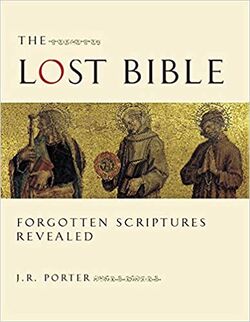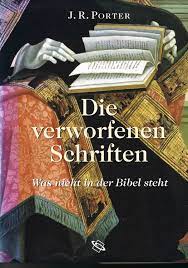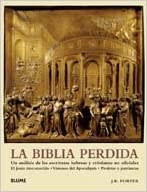Difference between revisions of "The Lost Bible (2001 Porter), book"
| (5 intermediate revisions by the same user not shown) | |||
| Line 1: | Line 1: | ||
'''The Lost Bible: Forgotten Scriptures Revealed''' (2001) | [[File:2001 Porter.jpg|thumb|250px]] | ||
[[File:2004 Porter de.jpg|thumb|250px]] | |||
[[File:2004 Porter es.jpg|thumb|250px]] | |||
[[Joshua Roy Porter]], '''''The Lost Bible: Forgotten Scriptures Revealed''''' ([[London, England]]: Duncan Baird; and [[Chicago, IL]]: University of Chicago Press, 2001). | |||
====Translations==== | |||
* ''German ed. (2004)'' : ''[[Die verworfenen Schriften = The Lost Bible (2004 Porter), book (German ed.)|Die verworfenen Schriften]]'' ([[Darmstadt, Germany]]: Wiss. Buchges., 2004) | |||
* ''Spanish ed. (2004)'' : ''[[La Biblia perdida = The Lost Bible (2010 Porter / Bastida Serra, Baber Casasnovas), book (Spanish ed.)|La Biblia perdida]]'', tr. [[Carolina Bastida Serra]] and [[Cristóbal Baber Casasnovas]] (Barcelona [Spain]: Naturart/Blume, 2004). | |||
==Abstract== | ==Abstract== | ||
Popular introduction to [[OT Pseudepigrapha]] and [[NT Apocrypha]] | Popular introduction to [[OT Pseudepigrapha]] and [[NT Apocrypha]]. | ||
The Lost Bible provides a fascinating introduction to sacred writings of great profundity and aesthetic merit that did not become part of the canon of the Old and New Testaments. In the centuries around the beginning of the Common Era, the Jewish people drew faith and inspiration from hundreds of sacred writings, not just those that make up the Hebrew Bible we know today. Early Christianity itself produced a wealth of sacred writings, which, though they did not become part of the New Testament, were popular among believers and important in spreading the faith. After the canons of the Jewish and Christian Bibles were established, many of these works disappeared into obscurity. Some were lost entirely; others survived in translations ... J.R. Porter introduces the reader to a wide selection of these extraordinary and beautiful "lost" works-from words considered to be those of prophets, kings, and patriarchs (even Adam himself) to legends and stories that supply "missing" parts of the Gospels. For each work, commentary is followed by a translated extract in clear and up-to-date language. The commentary places writings in their religious, social, and political context; explains the crucial importance of these works to the development of Jewish and Christian thought; and highlights the many legends and artistic traditions that sprang from them. It also examines the reasons-both religious and political-why these writings did not become part of the Jewish and Christian Bibles ... Lavishly illustrated with beautiful artwork, and amplified by maps, timelines, and data boxes, this text is a rich resource for anyone interested in exploring the origins of Judaism and Christianity. | |||
"The volume presents an annotated selection of ancient scriptures that did not become part of the canons of the Jewish and Christian Bibles, including the words of prophets, kings, and patriarchs, and examines the reasons why the writings were not included in the Hebrew scriptures or New Testament ... In the centuries around the beginning of the Common Era, both the Jewish faith and the early Christian church drew upon a wealth of spiritual stories and sacred writings that were nonetheless never included in the Hebrew Bible or the New Testament. With deft and profound scholarship, J. R. Porter gathers more than 100 such texts—including what were purported to be words written by Eve herself as well as stories of the strange miracles and violent outbursts of the boy Jesus—and assesses their context, character, and importance. Each fragment includes an introduction and commentary alongside a translation of the extract, as well as richly evocative illustrations that underline the power, insights, and literary merits of these writings. | |||
En los siglos alrededor del comienzo de la era común, tanto la fe judía así como la iglesia cristiana temprana recurrían a una abundancia de historias espirituales y escrituras sagradas que no obstante nunca fueron incluidas en la Biblia hebrea o el Nuevo Testamento. Con una erudición profunda y hábil, J. R. Porter reúne más de 100 tales textos—incluyendo los que se dicen ser palabras escritas por Eva misma y historias de los milagros extraños y arrebatos violentos del niño Jesús—y analiza su contexto, su carácter y su importancia. Cada fragmento incluye una introducción y un comentario junto con una traducción del extracto, así como ilustraciones evocadoras que resaltan el poder, las perspicacias y los méritos literarios de estas escrituras. | |||
==== | Un estudio de los textos sagrados que no se incorporaron en las Biblias judía y cristiana. Desde versiones alternativas de los contenidos bíblicos hasta sorprendentes concepciones del futuro. Más de 100 extractos de texto, cada uno acompañado de un comentario, imágenes y datos concretos. Una obra accesible y bellamente ilustrada que presenta una selección de textos ricos en carácter, acontecimientos y profundidad espiritual. Durante siglos, la mayoría de estos textos permanecieron ocultos, salvo para un reducido círculo de estudiosos y teólogos. Con una gran habilidad y extensos conocimientos académicos, J.R. Porter presenta al lector una antología de extraordinarios textos antiguos, y analiza su contexto, su carácter y su importancia. En cada una de las obras seleccionadas, los comentarios están acompañados de un fragmento traducido y adaptado a un lenguaje sencillo y actualizado. Entre las magníficas ilustraciones se encuentran muchas de las obras de arte inspiradas directamente en las leyendas y tradiciones contenidas en estos textos, olvidados durante tantos siglos. | ||
==Contents== | |||
Pt. 1. "Lost" Hebrew Scriptures -- Ch. 1. In the Beginning -- Ch. 2. Words of the Patriarchs -- Ch. 3. Lost Writings of the Prophets -- Ch. 4. Psalms, Songs, and Odes -- Ch. 5. Wisdom and Philosophy -- Pt. 2. "Lost" New Testament -- Ch. 1. Missing Years of Jesus -- Ch. 2. Gospels of the Passion -- Ch. 3. Gnostic Mysteries -- Ch. 4. Legends of the Apostles -- Ch. 5. Visions of the End of Time -- Ch. 6. Lost Letters to the Faithful. | |||
==== Spanish ed. (2004) ==== | |||
*Introducción | |||
Primera parte : Las escrituras hebreas "perdidas" | |||
* | *Capítulo 1: Al principio : La creación del mundo -- La creación de los ángeles -- Los ángeles y su labor -- La caída de Satanás y los ángeles rebeldes -- Adán y la caída -- Explicación de Eva de la caída -- Los ritmos del tiempo -- Enoc el sabio -- La venida del Hijo del Hombre -- Visiones cósmicas -- Capítulo 2: Palabras de los patriarcas : El Testamento de Abraham -- El Apocalipsis de Abraham -- El Testamento de Isaac -- El Testamento de Jacob -- Los testamentos de los doce patriarcas -- El Testamento de Rubén -- El Testamento de Simeón -- El Testamento de Leví -- El Testamento de Judá -- El Testamento de Isacar -- El Testamento de José -- José y Asenat -- El Testamento de Moisés -- Pseudo-Filón -- Capítulo 3: Escrituras perdidas de los profetas : Vidas de los profetas -- Historia de los recabitas -- El Testamento de Salomón -- El Apocalipsis de Elías -- El Apocalipsis de Sofonías -- Martirio y ascensión de Isaías -- El Segundo libro de Baruc -- El Tercer libro de Baruc -- El Cuarto libro de Baruc -- Las visiones de Esdras -- El Apocalipsis de Sedrac -- El Testamento de Job -- Los oráculos sibilinos -- La Carta de Aristeas -- Capítulo 4: Salmos, cantos y odas : Los Salmos de Salomón -- Lamentos y confesiones -- Las Odas de Salomón -- Himnos y cantos -- Capítulo 5: Sabiduría y filosofía : Las Palabras de Ahikar -- El Tercer libro de los Macabeos -- El Cuarto libro de los Macabeos -- Pseudo-Focílides. | ||
Segunda parte : El Nuevo Testamento perdido | |||
*Capítulo 1: Los años perdidos : Los abuelos de Cristo -- Las leyendas de la navidad -- Historias de la infancia de Jesús -- Los evangelios de los cristianos judíos -- Capítulo 2 : Los evangelios de la pasión -- El Evangelio de Pedro -- El Evangelio de Nicodemo -- Tradición y sentencia de Pilatos -- El Evangelio de Bartolomé -- Capítulo 3 : Los misterios gnósticos : La herejia gnóstica -- El Evangelio de la Verdad -- El Evangelio de Felipe -- El Evangelio copto de Tomás -- Los diálogos con Cristo -- Capítulo 4 : Leyendas de los apóstoles : Los hechos apócrifos -- Los Hechos de Pedro -- El martirio de Pedro -- Los Hechos de Juan -- Los Hechos de Pablo -- Pablo y el león -- Pablo en Filipos -- Pablo en Corinto -- El martirio de Pablo -- Los Hechos de Andrés -- Tomás en la India -- Migdonia y Carisio -- Ritos y oraciones sagrados -- El "Canto de la perla" -- El martirio de Tomás -- Capítulo 5 : Las visiones del fin del mundo : El Apocalipsis de Pedro -- El Apocalipsis de Pablo -- Los apocalipsis gnósticos -- El Apocalipsis de Tomás -- La sibila cristiana -- Capítulo 6 : Cartas perdidas a los fieles : Abgar y Jesús -- Carta a los Laodicenses -- Pablo y Séneca -- La Carta de pseudo-Tito -- Las predicaciones de Pedro -- Carta de los Apóstoles. | |||
==External links== | ==External links== | ||
Latest revision as of 16:52, 19 January 2022
Joshua Roy Porter, The Lost Bible: Forgotten Scriptures Revealed (London, England: Duncan Baird; and Chicago, IL: University of Chicago Press, 2001).
Translations
- German ed. (2004) : Die verworfenen Schriften (Darmstadt, Germany: Wiss. Buchges., 2004)
- Spanish ed. (2004) : La Biblia perdida, tr. Carolina Bastida Serra and Cristóbal Baber Casasnovas (Barcelona [Spain]: Naturart/Blume, 2004).
Abstract
Popular introduction to OT Pseudepigrapha and NT Apocrypha.
The Lost Bible provides a fascinating introduction to sacred writings of great profundity and aesthetic merit that did not become part of the canon of the Old and New Testaments. In the centuries around the beginning of the Common Era, the Jewish people drew faith and inspiration from hundreds of sacred writings, not just those that make up the Hebrew Bible we know today. Early Christianity itself produced a wealth of sacred writings, which, though they did not become part of the New Testament, were popular among believers and important in spreading the faith. After the canons of the Jewish and Christian Bibles were established, many of these works disappeared into obscurity. Some were lost entirely; others survived in translations ... J.R. Porter introduces the reader to a wide selection of these extraordinary and beautiful "lost" works-from words considered to be those of prophets, kings, and patriarchs (even Adam himself) to legends and stories that supply "missing" parts of the Gospels. For each work, commentary is followed by a translated extract in clear and up-to-date language. The commentary places writings in their religious, social, and political context; explains the crucial importance of these works to the development of Jewish and Christian thought; and highlights the many legends and artistic traditions that sprang from them. It also examines the reasons-both religious and political-why these writings did not become part of the Jewish and Christian Bibles ... Lavishly illustrated with beautiful artwork, and amplified by maps, timelines, and data boxes, this text is a rich resource for anyone interested in exploring the origins of Judaism and Christianity.
"The volume presents an annotated selection of ancient scriptures that did not become part of the canons of the Jewish and Christian Bibles, including the words of prophets, kings, and patriarchs, and examines the reasons why the writings were not included in the Hebrew scriptures or New Testament ... In the centuries around the beginning of the Common Era, both the Jewish faith and the early Christian church drew upon a wealth of spiritual stories and sacred writings that were nonetheless never included in the Hebrew Bible or the New Testament. With deft and profound scholarship, J. R. Porter gathers more than 100 such texts—including what were purported to be words written by Eve herself as well as stories of the strange miracles and violent outbursts of the boy Jesus—and assesses their context, character, and importance. Each fragment includes an introduction and commentary alongside a translation of the extract, as well as richly evocative illustrations that underline the power, insights, and literary merits of these writings.
En los siglos alrededor del comienzo de la era común, tanto la fe judía así como la iglesia cristiana temprana recurrían a una abundancia de historias espirituales y escrituras sagradas que no obstante nunca fueron incluidas en la Biblia hebrea o el Nuevo Testamento. Con una erudición profunda y hábil, J. R. Porter reúne más de 100 tales textos—incluyendo los que se dicen ser palabras escritas por Eva misma y historias de los milagros extraños y arrebatos violentos del niño Jesús—y analiza su contexto, su carácter y su importancia. Cada fragmento incluye una introducción y un comentario junto con una traducción del extracto, así como ilustraciones evocadoras que resaltan el poder, las perspicacias y los méritos literarios de estas escrituras.
Un estudio de los textos sagrados que no se incorporaron en las Biblias judía y cristiana. Desde versiones alternativas de los contenidos bíblicos hasta sorprendentes concepciones del futuro. Más de 100 extractos de texto, cada uno acompañado de un comentario, imágenes y datos concretos. Una obra accesible y bellamente ilustrada que presenta una selección de textos ricos en carácter, acontecimientos y profundidad espiritual. Durante siglos, la mayoría de estos textos permanecieron ocultos, salvo para un reducido círculo de estudiosos y teólogos. Con una gran habilidad y extensos conocimientos académicos, J.R. Porter presenta al lector una antología de extraordinarios textos antiguos, y analiza su contexto, su carácter y su importancia. En cada una de las obras seleccionadas, los comentarios están acompañados de un fragmento traducido y adaptado a un lenguaje sencillo y actualizado. Entre las magníficas ilustraciones se encuentran muchas de las obras de arte inspiradas directamente en las leyendas y tradiciones contenidas en estos textos, olvidados durante tantos siglos.
Contents
Pt. 1. "Lost" Hebrew Scriptures -- Ch. 1. In the Beginning -- Ch. 2. Words of the Patriarchs -- Ch. 3. Lost Writings of the Prophets -- Ch. 4. Psalms, Songs, and Odes -- Ch. 5. Wisdom and Philosophy -- Pt. 2. "Lost" New Testament -- Ch. 1. Missing Years of Jesus -- Ch. 2. Gospels of the Passion -- Ch. 3. Gnostic Mysteries -- Ch. 4. Legends of the Apostles -- Ch. 5. Visions of the End of Time -- Ch. 6. Lost Letters to the Faithful.
Spanish ed. (2004)
- Introducción
Primera parte : Las escrituras hebreas "perdidas"
- Capítulo 1: Al principio : La creación del mundo -- La creación de los ángeles -- Los ángeles y su labor -- La caída de Satanás y los ángeles rebeldes -- Adán y la caída -- Explicación de Eva de la caída -- Los ritmos del tiempo -- Enoc el sabio -- La venida del Hijo del Hombre -- Visiones cósmicas -- Capítulo 2: Palabras de los patriarcas : El Testamento de Abraham -- El Apocalipsis de Abraham -- El Testamento de Isaac -- El Testamento de Jacob -- Los testamentos de los doce patriarcas -- El Testamento de Rubén -- El Testamento de Simeón -- El Testamento de Leví -- El Testamento de Judá -- El Testamento de Isacar -- El Testamento de José -- José y Asenat -- El Testamento de Moisés -- Pseudo-Filón -- Capítulo 3: Escrituras perdidas de los profetas : Vidas de los profetas -- Historia de los recabitas -- El Testamento de Salomón -- El Apocalipsis de Elías -- El Apocalipsis de Sofonías -- Martirio y ascensión de Isaías -- El Segundo libro de Baruc -- El Tercer libro de Baruc -- El Cuarto libro de Baruc -- Las visiones de Esdras -- El Apocalipsis de Sedrac -- El Testamento de Job -- Los oráculos sibilinos -- La Carta de Aristeas -- Capítulo 4: Salmos, cantos y odas : Los Salmos de Salomón -- Lamentos y confesiones -- Las Odas de Salomón -- Himnos y cantos -- Capítulo 5: Sabiduría y filosofía : Las Palabras de Ahikar -- El Tercer libro de los Macabeos -- El Cuarto libro de los Macabeos -- Pseudo-Focílides.
Segunda parte : El Nuevo Testamento perdido
- Capítulo 1: Los años perdidos : Los abuelos de Cristo -- Las leyendas de la navidad -- Historias de la infancia de Jesús -- Los evangelios de los cristianos judíos -- Capítulo 2 : Los evangelios de la pasión -- El Evangelio de Pedro -- El Evangelio de Nicodemo -- Tradición y sentencia de Pilatos -- El Evangelio de Bartolomé -- Capítulo 3 : Los misterios gnósticos : La herejia gnóstica -- El Evangelio de la Verdad -- El Evangelio de Felipe -- El Evangelio copto de Tomás -- Los diálogos con Cristo -- Capítulo 4 : Leyendas de los apóstoles : Los hechos apócrifos -- Los Hechos de Pedro -- El martirio de Pedro -- Los Hechos de Juan -- Los Hechos de Pablo -- Pablo y el león -- Pablo en Filipos -- Pablo en Corinto -- El martirio de Pablo -- Los Hechos de Andrés -- Tomás en la India -- Migdonia y Carisio -- Ritos y oraciones sagrados -- El "Canto de la perla" -- El martirio de Tomás -- Capítulo 5 : Las visiones del fin del mundo : El Apocalipsis de Pedro -- El Apocalipsis de Pablo -- Los apocalipsis gnósticos -- El Apocalipsis de Tomás -- La sibila cristiana -- Capítulo 6 : Cartas perdidas a los fieles : Abgar y Jesús -- Carta a los Laodicenses -- Pablo y Séneca -- La Carta de pseudo-Tito -- Las predicaciones de Pedro -- Carta de los Apóstoles.
External links
- 2001
- English language--2000s
- Second Temple Studies--2000s
- Second Temple Studies--English
- OT Pseudepigrapha Studies--2000s
- OT Pseudepigrapha Studies--English
- Early Christian Studies--2000s
- Early Christian Studies--English
- NT Apocrypha Studies--2000s
- NT Apocrypha Studies--English
- OT Pseudepigrapha Intro (subject)
- NT Apocrypha Intro (subject)
- Top 2000s
- International Bestsellers


